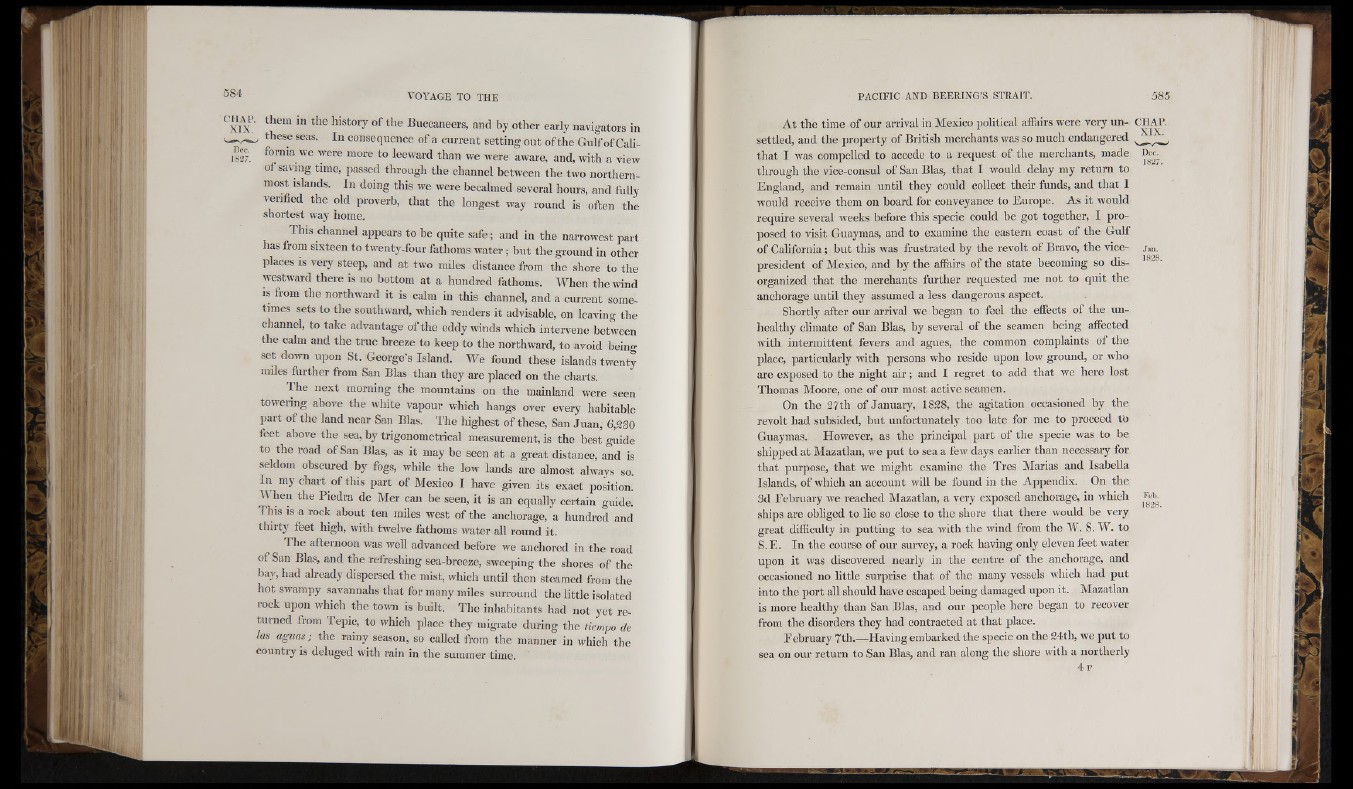
|j! 'ii[Vi' 'Ii
(ri
i t o
li re
r i l r i ™ liistory of the Buccaneers, and by other early navigators in
,— ^ these seas. In consequence of a current setting out ofthe Gulfof Cali-
fornia we were more to leeward than we were aware, and, with a view
of saving time, passed through the channel betw-een the two northernmost
islands. In doing this we were becalmed several hours, and fully
verified the old proverb, that the longest way round is often the
shortest way home.
This channel appears to be quite safe ; and in the narrowest part
has from sixteen to twenty-four fathoms water ; but the ground in other
places IS very steep, and at two miles distance from the shore to the
westward there is no bottom at a hundred fathoms. When the wind
IS from the northward it is calm in this channel, and a current sometimes
sets to the southward, which renders it advisable, on leaving the
channel, to take advantage of the eddy winds which intervene between
the calm and the true breeze to keep to the northward, to avoid being
set down upon St. George’s Island. We found these islands twenty
miles further from San Bias than they are placed on the charts.
The next morning the mountains on the mainland were seen
towering above the white vapour which hangs over every habitable
part of the land near San Bias. The highest of these, San Juan, 6,230
feet above the sea, by trigonometrical measurement, is the best guide
to the road of San Bias, as it may be seen at a great distance, and is
seldom obscured by fogs, while the low lands are almost always so.
In my chart of this part of Mexico I have given its exact position.
AVhen the Piedra de Mer can be seen, it is an equally certain guide.
I his IS a rock about ten miles west of the anchorage, a hundred and
tliirty feet high, with twelve fathoms water all round it.
The afternoon was well advanced before we anchored in the road
of San Bias, and the refreshing sea-breeze, sweeping the shores of the
bay, had already dispersed the mist, which until then steamed from the
hot swampy savannahs that for many miles surround the little isolated
rock upon which the town is built. The inhabitants had not yet returned
from Tepic, to which place they migrate during the tiem p o de
las aguas; the rainy season, so called from the manner in which the
country is deluged with rain in the summer time.
•r"
if
At the time of our arrival in Mexico political affairs were very un- CHAP.
settled, and the property of British merchants was so much endangered
that I was compelled to accede to a request of the merchants, made Dm_
through the vice-consul of San Bias, that I w-ould delay my return to
England, and remain until they could collect their funds, and that 1
would receive them on board for conveyance to Europe. As it would
require several weeks before this specie could be got together, I proposed
to visit Guaymas, and to examine the eastern coast of the Gulf
of CaUfornia ; but this w-as frustrated by the revolt of Bravo, the vice- jan.
president of Mexico, and by the affairs ofth e state becoming so dis-
organized that the merchants further requested me not to quit the
anchorage until they assumed a less dangerous aspect.
Shortly after our arrival we began to feel the effects of the unhealthy
climate of San Bias, by several of the seamen being affected
with intermittent fevers and agues, the common complaints of the
place, particularly with persons who reside upon low ground, or who
are exposed to the night air ; and I regret to add that we here lost
Thomas Moore, one of our most active seamen.
On the 27th of January, 1828, the agitation occasioned by the
revolt had subsided, but unfortunately too late for me to proceed to
Guaymas. However, as the principal part of the specie was to be
shipped at Mazatlan, we put to sea a few days earlier than necessary for
that purpose, that we might examine the Tres Marias and Isabella
Islands, of which an account will be found in the Appendix. On the
Sd February we reached Mazatlan, a very exposed anchorage, in which
ships are obliged to lie so close to the shore that there would be very
great difficulty in putting to sea with the wind from the AV. S.AA". to
S.E. In the course of our survey, a rock having only eleven feet water
upon it was discovered nearly in the centre of the anchorage, and
occasioned no little surprise that of the many vessels which had put
into the port all should have escaped being damaged upon it. Mazatlan
is more healthy than San Bias, and our people here began to recover
from tlie disorders they had contracted at that place.
February 7th.—Having embarked the specie on the 24th, we put to
sea on our return to San Bias, and ran along the shore with a northerly
4 f
Feb.
1828.